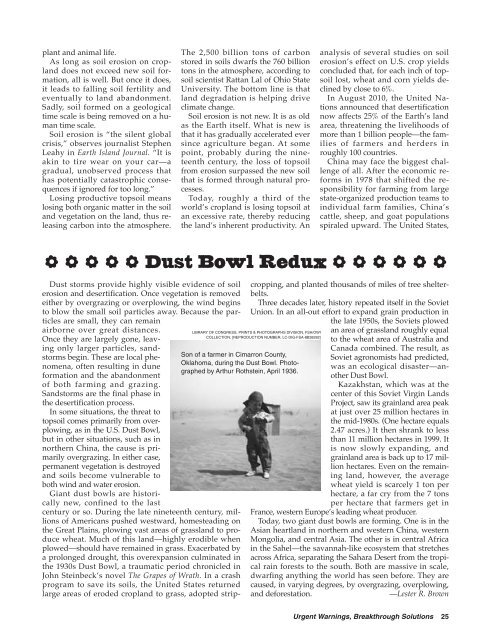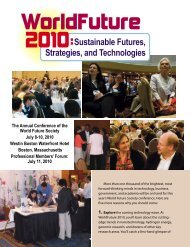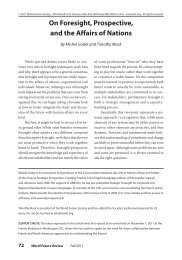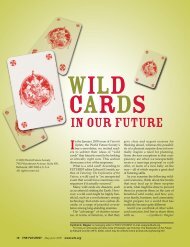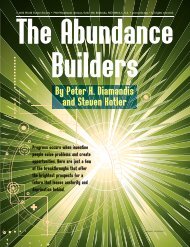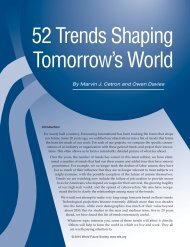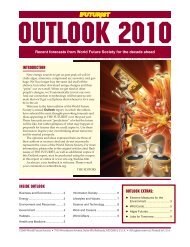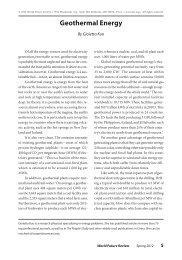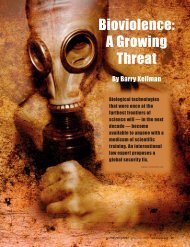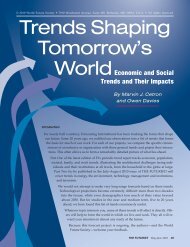Urgent Warnings, Breakthrough Solutions, Second Edition
Urgent Warnings, Breakthrough Solutions, Second Edition
Urgent Warnings, Breakthrough Solutions, Second Edition
You also want an ePaper? Increase the reach of your titles
YUMPU automatically turns print PDFs into web optimized ePapers that Google loves.
plant and animal life.<br />
As long as soil erosion on cropland<br />
does not exceed new soil formation,<br />
all is well. But once it does,<br />
it leads to falling soil fertility and<br />
eventually to land abandonment.<br />
Sadly, soil formed on a geological<br />
time scale is being removed on a human<br />
time scale.<br />
Soil erosion is “the silent global<br />
crisis,” observes journalist Stephen<br />
Leahy in Earth Island Journal. “It is<br />
akin to tire wear on your car—a<br />
gradual, unobserved process that<br />
has potentially catastrophic consequences<br />
if ignored for too long.”<br />
Losing productive topsoil means<br />
losing both organic matter in the soil<br />
and vegetation on the land, thus releasing<br />
carbon into the atmosphere.<br />
The 2,500 billion tons of carbon<br />
stored in soils dwarfs the 760 billion<br />
tons in the atmosphere, according to<br />
soil scientist Rattan Lal of Ohio State<br />
University. The bottom line is that<br />
land degradation is helping drive<br />
climate change.<br />
Soil erosion is not new. It is as old<br />
as the Earth itself. What is new is<br />
that it has gradually accelerated ever<br />
since agriculture began. At some<br />
point, probably during the nineteenth<br />
century, the loss of topsoil<br />
from erosion surpassed the new soil<br />
that is formed through natural processes.<br />
Today, roughly a third of the<br />
world’s cropland is losing topsoil at<br />
an excessive rate, thereby reducing<br />
the land’s inherent productivity. An<br />
analysis of several studies on soil<br />
erosion’s effect on U.S. crop yields<br />
concluded that, for each inch of topsoil<br />
lost, wheat and corn yields declined<br />
by close to 6%.<br />
In August 2010, the United Nations<br />
announced that desertification<br />
now affects 25% of the Earth’s land<br />
area, threatening the livelihoods of<br />
more than 1 billion people—the families<br />
of farmers and herders in<br />
roughly 100 countries.<br />
China may face the biggest challenge<br />
of all. After the economic reforms<br />
in 1978 that shifted the responsibility<br />
for farming from large<br />
state-organized production teams to<br />
individual farm families, China’s<br />
cattle, sheep, and goat populations<br />
spiraled upward. The United States,<br />
S S S S S Dust Bowl Redux S S S S S S<br />
Dust storms provide highly vis ible evidence of soil<br />
erosion and desertification. Once vegetation is removed<br />
either by overgrazing or overplowing, the wind begins<br />
to blow the small soil particles away. Because the particles<br />
are small, they can remain<br />
airborne over great distances.<br />
Once they are largely gone, leaving<br />
only larger particles, sandstorms<br />
begin. These are local phenomena,<br />
often resulting in dune<br />
formation and the abandonment<br />
of both farming and grazing.<br />
Sandstorms are the final phase in<br />
the desertification process.<br />
In some situations, the threat to<br />
topsoil comes primarily from overplowing,<br />
as in the U.S. Dust Bowl,<br />
but in other situations, such as in<br />
northern China, the cause is primarily<br />
overgrazing. In either case,<br />
permanent vegetation is destroyed<br />
and soils become vulnerable to<br />
both wind and water erosion.<br />
Giant dust bowls are historically<br />
new, confined to the last<br />
century or so. During the late nineteenth century, millions<br />
of Americans pushed westward, homesteading on<br />
the Great Plains, plowing vast areas of grassland to produce<br />
wheat. Much of this land—highly erodible when<br />
plowed—should have remained in grass. Exacerbated by<br />
a prolonged drought, this overexpansion culminated in<br />
the 1930s Dust Bowl, a traumatic period chronicled in<br />
John Steinbeck’s novel The Grapes of Wrath. In a crash<br />
program to save its soils, the United States returned<br />
large areas of eroded cropland to grass, adopted strip-<br />
cropping, and planted thousands of miles of tree shelterbelts.<br />
Three decades later, history repeated itself in the Soviet<br />
Union. In an all-out effort to expand grain production in<br />
the late 1950s, the Soviets plowed<br />
an area of grassland roughly equal<br />
to the wheat area of Australia and<br />
Canada combined. The result, as<br />
Soviet agronomists had predicted,<br />
was an ecological disaster—another<br />
Dust Bowl.<br />
Kazakhstan, which was at the<br />
center of this Soviet Virgin Lands<br />
Project, saw its grainland area peak<br />
at just over 25 million hectares in<br />
the mid-1980s. (One hectare equals<br />
2.47 acres.) It then shrank to less<br />
than 11 million hectares in 1999. It<br />
is now slowly expanding, and<br />
grainland area is back up to 17 million<br />
hectares. Even on the remaining<br />
land, however, the average<br />
wheat yield is scarcely 1 ton per<br />
hectare, a far cry from the 7 tons<br />
per hectare that farmers get in<br />
France, western Europe’s leading wheat producer.<br />
Today, two giant dust bowls are forming. One is in the<br />
Asian heartland in northern and western China, western<br />
Mongolia, and central Asia. The other is in central Africa<br />
in the Sahel—the savannah-like ecosystem that stretches<br />
across Africa, separating the Sahara Desert from the tropical<br />
rain forests to the south. Both are massive in scale,<br />
dwarfing anything the world has seen before. They are<br />
LIBRARY OF CONGRESS, PRINTS & PHOTOGRAPHS DIVISION, FSA/OWI<br />
COLLECTION, [REPRODUCTION NUMBER, LC-DIG-FSA-8B38282]<br />
Son of a farmer in Cimarron County,<br />
Oklahoma, during the Dust Bowl. Photographed<br />
by Arthur Rothstein, April 1936.<br />
caused, in varying degrees, by overgrazing, overplowing,<br />
and deforestation.<br />
—Lester R. Brown<br />
<strong>Urgent</strong> <strong>Warnings</strong>, <strong>Breakthrough</strong> <strong>Solutions</strong> 25


